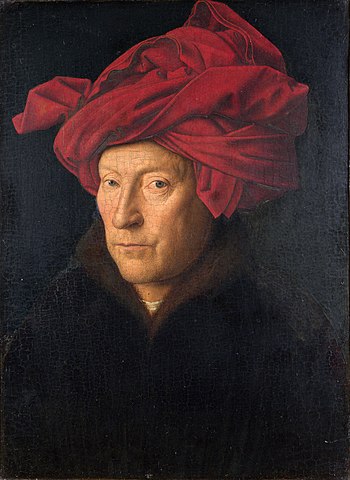
Born: 1380 or 1390, Maaseik
Died: 9 July 1441 (aged 61-71)
Period: Northern Reniassance
The Life of Jan van Eyck
Jan van Eyck, born around 1390 in Maaseik, then part of the Holy Roman Empire (now in modern-day Belgium), was a pivotal figure of the Northern Renaissance. His exact date of birth is not known, but his career as a painter is well-documented from the early 15th century until his death in Bruges in 1441. Van Eyck was not only a painter but also a court artist and diplomat for Philip the Good, Duke of Burgundy, one of the most powerful European rulers of the era. This position allowed him to travel extensively across Europe, which influenced his art significantly.
Van Eyck’s work is renowned for its meticulous detail, vibrant color, and pioneering use of oil-based paints. His technique with oil paints was so advanced that he was once mistakenly credited with inventing oil painting. This mastery enabled him to achieve a level of detail and realism that was unprecedented for his time, particularly in the rendering of textures and effects of light. Among his most famous works is the “Ghent Altarpiece,” completed in 1432, which he worked on with his brother Hubert van Eyck, and the “Arnolfini Portrait” (1434), celebrated for its complexity and iconography.
Jan van Eyck’s paintings are characterized by their intricate detail and symbolic elements, often religious or allegorical in nature. His portraits, too, are notable for their realism and depth, presenting subjects with a profound sense of individuality and character.
Van Eyck’s influence extended far beyond his lifetime, contributing significantly to the development of painting in the Northern Renaissance. His techniques and approach to naturalism and detail influenced many subsequent artists, and his works have been studied and admired for centuries. Van Eyck’s legacy is preserved in collections around the world, most notably in Belgium, the Netherlands, Germany, and Italy, offering insight into the artistic, cultural, and social contexts of 15th-century Europe.
Jan van Eyck’s Notable Works
masterpieces of Northern Renaissance art. Here are ten of his most famous and influential works:
- The Ghent Altarpiece (1432) – Also known as “The Adoration of the Mystic Lamb,” this monumental polyptych is Van Eyck’s most famous work, created in collaboration with his brother Hubert. Located at Saint Bavo’s Cathedral in Ghent, Belgium, it’s celebrated for its intricate detail and innovative use of oil paint.
- The Arnolfini Portrait (1434) – This painting, housed in the National Gallery, London, depicts Giovanni di Nicolao Arnolfini and his wife in their home and is renowned for its detailed rendering and use of perspective, as well as its complex symbolism.
- Man in a Red Turban (1433) – Believed to be a self-portrait, this work is notable for its realistic representation and the detailed textures of the man’s face and turban. It’s also one of the earliest Western artworks to feature the artist’s signature.
- The Madonna of Chancellor Rolin (1435) – This painting, showcasing Chancellor Rolin of Burgundy in prayer with the Virgin Mary and Child, is famed for its exquisite detail and the depiction of a panoramic landscape seen through a window.
- Portrait of Baudouin de Lannoy (c. 1435) – Located in the Gemäldegalerie, Berlin, this portrait is celebrated for its meticulous detail and the dignified portrayal of the sitter, a member of the Order of the Golden Fleece.
- The Madonna with Canon van der Paele (1436) – This painting, which features the Virgin Mary with Saint Donatian and Canon George van der Paele, is renowned for its detailed realism and the sumptuous textures of the fabrics.
- Saint Jerome in His Study (c. 1442) – Although attribution has been debated, this work is often considered one of Van Eyck’s, noted for its attention to detail in the depiction of textures and light.
- The Annunciation (c. 1434–1436) – Housed in the National Gallery of Art, Washington D.C., this painting is celebrated for its depiction of the Archangel Gabriel announcing to Mary that she will bear the Son of God, noted for its detailed rendering and use of light.
- Portrait of a Man (Léal Souvenir) (1432) – This portrait, believed to depict the Italian merchant Tito di Pietro della Valle, is known for its realism and the contemplative mood it captures.
- The Madonna at the Church (c. 1438) – A smaller panel painting that shows the Virgin Mary in a Gothic church, this work is admired for its intricate detail, especially in the rendering of the church’s architecture and the play of light through its windows.
Jan van Eyck’s oeuvre is celebrated for its innovative use of oil paint, mastery of detail, and depth of symbolic meaning, making his works some of the most studied and admired in the history of art.